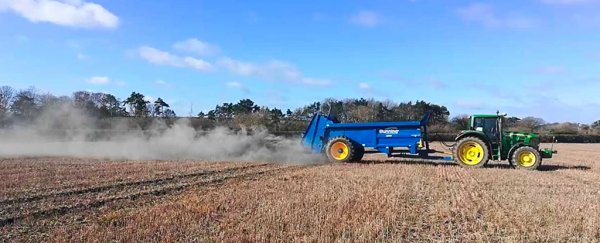Drastically reducing the amount of carbon dioxide (CO2) we're pumping into the atmosphere is the best way of tackling our climate crisis, but soaking up CO2 could make a huge difference as well – and scientists have found one way to significantly boost the amount of CO2 that crops are able to absorb.
The trick is adding crushed rock dust, which triggers a reaction known as enhanced rock weathering (ERW): minerals in the tiny bits of rock chemically bind with the CO2 naturally picked up by rainwater as it falls on the ground.
The bicarbonate end product then washes away to be locked into the soil or, ultimately, the ocean.
Rock weathering happens naturally, but it speeds up when smaller rock particles are used so that it only takes months.
The simple addition to crops would be enough to remove 2 billion tonnes of CO2 every year if it was deployed worldwide, the scientists calculated.
That's about as much CO2 as the aviation and shipping industries pump into the atmosphere every year.
"Carbon dioxide drawdown strategies that can scale up and are compatible with existing land uses are urgently required to combat climate change, alongside deep and sustained emissions cuts," says David Beerling, the director of the Leverhulme Centre for Climate Change Mitigation at the University of Sheffield in the UK.
"Spreading rock dust on agricultural land is a straightforward, practical CO2 drawdown approach with the potential to boost soil health and food production."
The analysis involved creating extensive gridded maps of the world's farmland and the weather systems that they experience. Costs, engineering challenges, and CO2 removal potential were broken down by country.
Even the quality of the local soil and the energy required to transport rock dust to each location was factored in as well, as there's little point removing CO2 from the atmosphere if we're going to be emitting even more in the effort to get the necessary materials to farmers in the first place.
The 2 billion tonne figure they came up with is something the researchers think we could get to by 2050, with everyone pulling together. While the approach is not without its challenges, it does have certain factors in its favour – not least that farmers already do something like it.
"The practice of spreading crushed rock to improve soil pH is commonplace in many agricultural regions worldwide," says Steven Banwart, director of the Global Food and Environment Institute at the University of Leeds in the UK.
"The technology and infrastructure already exist to adapt these practices to utilise basalt rock dust. This offers a potentially rapid transition in agricultural practices to help capture CO2 at large scale."
The technique has a number of bonuses. It can help stop the deterioration of topsoil, it reduces the acidity of rainwater (and also the acidity of the oceans), and we could use stockpiles of silicate rock dust left over from the mining industry as well as construction byproducts for the job.
Scientists have been exploring this idea for a number of years, but this is the first detailed report on the potential global cost and effect of ERW. The nations with the highest CO2 output, including the US and India, could suck up the most carbon dioxide the researchers say, because of their extensive agricultural industries and climates.
All that said, this would still be a huge challenge: efforts would need to be carefully coordinated across the world's farms, any efforts would need to be well funded, and, unfortunately, adding rock dust to crops isn't going to be nearly enough to save us on its own.
What's more, this detailed model now needs real-world testing to back it up and check for any potential and unwanted side effects.
Still, we need options like this now more than ever.
"We have passed the safe level of greenhouse gases," says climatologist James Hansen, from Columbia University.
"Cutting fossil fuel emissions is crucial, but we must also extract atmospheric CO2 with safe, secure and scalable carbon dioxide removal strategies to bend the global CO2 curve and limit future climate change."
The research has been published in Nature.
